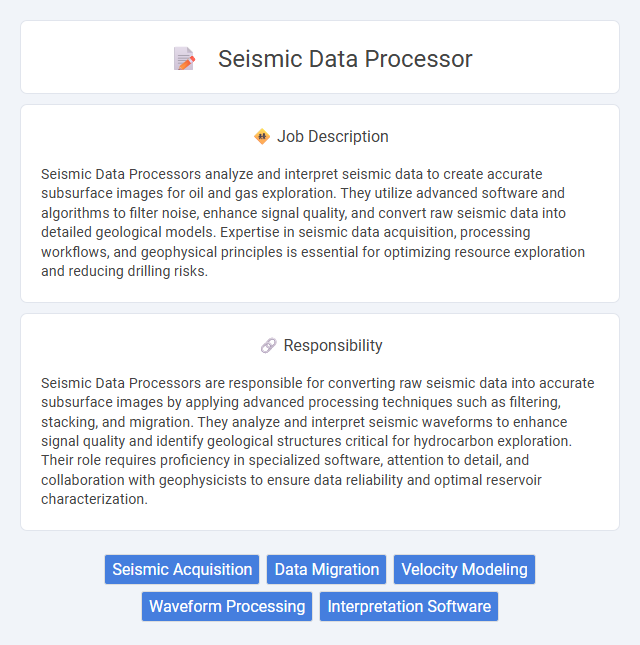
Seismic Data Processors analyze and interpret seismic data to create accurate subsurface images for oil and gas exploration. They utilize advanced software and algorithms to filter noise, enhance signal quality, and convert raw seismic data into detailed geological models. Expertise in seismic data acquisition, processing workflows, and geophysical principles is essential for optimizing resource exploration and reducing drilling risks.
Individuals with strong analytical skills and attention to detail are likely to find a seismic data processor role suitable due to the precision required in interpreting complex seismic datasets. Those who are comfortable working with advanced software and have a background in geology or geophysics may have a higher probability of success in this position. Candidates who prefer dynamic problem-solving environments and have patience for repetitive data analysis tasks might also be well-suited for this job.
Qualification
A Seismic Data Processor requires a strong background in geophysics, geology, or related fields, often holding a bachelor's or master's degree. Proficiency in seismic processing software such as ProMAX, Kingdom, or Petrel is essential for data interpretation and noise reduction. Strong analytical skills and experience with signal processing techniques enhance accuracy in subsurface imaging critical for hydrocarbon exploration.
Responsibility
Seismic Data Processors are responsible for converting raw seismic data into accurate subsurface images by applying advanced processing techniques such as filtering, stacking, and migration. They analyze and interpret seismic waveforms to enhance signal quality and identify geological structures critical for hydrocarbon exploration. Their role requires proficiency in specialized software, attention to detail, and collaboration with geophysicists to ensure data reliability and optimal reservoir characterization.
Benefit
Seismic Data Processor positions likely offer competitive salaries due to the technical expertise required, enhancing financial stability for professionals in this field. Opportunities for career advancement may arise as accumulated experience allows deeper specialization in seismic interpretation and data analysis. Access to cutting-edge technology and participation in diverse projects could provide ongoing skill development and job satisfaction.
Challenge
Seismic Data Processor roles likely present significant challenges related to the accuracy and interpretation of complex subsurface data, requiring advanced analytical skills and attention to detail. The probability of encountering ambiguous or noisy datasets means professionals must be proficient in using specialized software and methodologies to enhance data quality. Adapting to evolving technologies and varying geological environments may further complicate data processing tasks, demanding continuous learning and problem-solving capabilities.
Career Advancement
Seismic Data Processor roles offer significant opportunities for career advancement through mastering advanced geophysical software and gaining expertise in seismic interpretation techniques. Professionals who enhance their skills in algorithm development and data integration often progress to senior geophysicist or seismic imaging specialist positions. Continuous professional development and certification in seismic data analysis technologies are critical for accelerating growth within the oil and gas exploration and environmental assessment sectors.
Key Terms
Seismic Acquisition
Seismic data processors specialize in analyzing raw seismic acquisition data to enhance subsurface imaging for oil and gas exploration. They apply advanced algorithms and filtering techniques to correct, process, and interpret seismic signals collected from field surveys. Expertise in seismic acquisition technology and data quality control ensures accurate subsurface mapping critical for exploration success.
Data Migration
Seismic Data Processors specializing in data migration facilitate the transfer of complex geophysical datasets between diverse storage systems, ensuring data integrity and accessibility. They apply advanced algorithms and software tools to validate, reformat, and integrate seismic data for enhanced analysis and interpretation. Expertise in data migration minimizes downtime and preserves critical subsurface information vital for exploration and production activities.
Velocity Modeling
A Seismic Data Processor specializing in velocity modeling plays a critical role in subsurface imaging by analyzing seismic wave velocities to construct accurate earth models. Their expertise in velocity analysis directly improves the resolution of seismic sections, enabling precise identification of geological structures and stratigraphy. Proficiency in software such as Petrel, Kingdom, or Hampson-Russell is essential to refine velocity models and optimize seismic data interpretation workflows.
Waveform Processing
Seismic Data Processors specializing in waveform processing analyze raw seismic signals to enhance data quality and interpret subsurface geological features. They apply advanced algorithms such as deconvolution, filtering, and signal conditioning to extract meaningful patterns from noise-affected waveforms. Expertise in software tools like Seismic Unix and Python for signal processing ensures accurate imaging crucial for hydrocarbon exploration and earthquake analysis.
Interpretation Software
Seismic Data Processors specialize in utilizing advanced interpretation software such as Petrel, Kingdom Suite, and OpendTect to analyze subsurface geological formations. They apply algorithms to enhance signal quality, filter noise, and generate accurate seismic images that support oil and gas exploration. Mastery in software tools enables efficient handling of large datasets, facilitating precise modeling and decision-making in seismic interpretation.
 kuljobs.com
kuljobs.com